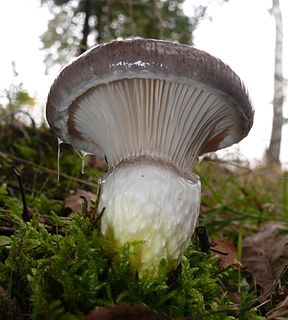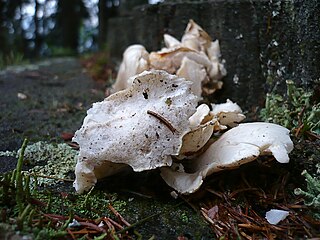Related Research Articles

Volvariella volvacea is a species of edible mushroom cultivated throughout East and Southeast Asia and used extensively in Asian cuisines. They are often available fresh in regions they are cultivated, but elsewhere are more frequently found canned or dried. Worldwide, straw mushrooms are the third most consumed mushroom.
Torula is a species of yeast.

Gomphidius is a genus of mushrooms, commonly known as spike-caps, that are members of the Boletales, or pored fungi. They appear to have gill-like structures which resemble those of agarics, however the similarity is superficial only. The best-known member is the slimy spike-cap. The genus has a widespread distribution, especially in north temperate areas, and contains 10 species.
Myrothecium verrucaria is a species of fungus in the order Hypocreales. A plant pathogen, it is common throughout the world, often found on materials such as paper, textiles, canvas and cotton. It is a highly potent cellulose decomposer.

Peniophora albobadia is a species of crust fungus in the family Peniophoraceae. It is a plant pathogen that affects stone fruits. First described scientifically by Lewis David de Schweinitz in 1822, it was transferred to the genus Peniophora by Jacques Boidin in 1961. It is most commonly found in the United States.
Rhizochaete is a plant pathogen infecting planes, beeches, pines, oaks and other trees.

Osteina is a fungal genus in the family Fomitopsidaceae. It is a monotypic genus that contains the single species Osteina obducta. The genus was circumscribed by mycologist Marinus Anton Donk in 1966, with Polyporus obductus as the type species.
Neocallimastix is a genus of obligately anaerobic rumen fungi in the family Neocallimastigaceae. A specialised group of chytrids grow in the rumen of herbivorous animals, where they degrade cellulose and thus play a primary role in the complex microbial ecology of the rumen.

Phellorinia is a genus of fungi in the family Phelloriniaceae of the order Agaricales. The genus is monotypic, and contains the single species Phellorinia herculeana, described by English naturalist Miles Joseph Berkeley in 1843 as P. inquinans. This single species has currently 24 synonyms, and takes its epithet from the basionym Scleroderma herculeanum Pers.

Suillellus queletii, commonly known as the deceiving bolete, is an uncommon, edible mushroom in the genus Suillellus.
Duddingtonia is a genus of fungi in the family Orbiliaceae comprising only the species Duddingtonia flagrans.

Clavulinopsis sulcata is a coral fungus in the family Clavariaceae. It was originally described by Miles Joseph Berkeley in 1843 as Clavaria miniata, from collections made in Uitenhage, South Africa. Dutch mycologist Casper van Overeem gave it the name by which it is now known in 1923, when he made it the type species of the newly circumscribed genus Clavulinopsis.

Suillus flavidus is a bolete mushroom in the genus Suillus native to Europe. It is considered endangered in the Czech Republic and Switzerland. It is also considered edible, but with an unpleasant taste.
Hydnellum rickeri is a tooth fungus in the family Bankeraceae. Found in North America, it was described as new to science in 1913 by mycologist Howard James Banker from collections made in Orono, Maine. It is named after botanist Percy L. Ricker, who collected the type specimen. Fruit bodies are dingy brown to olive-colored, and have a strong, spicy odor that persists after they have dried.

Bondarzewia mesenterica is a species of polypore fungus in the family Bondarzewiaceae. It was first described as Boletus mesentericus by Jacob Christian Schäffer in 1774. Hanns Kreisel transferred it to the genus Bondarzewia in 1984. The species is edible.

Lactarius trivialis is a species of mushroom belonging to the genus Lactarius. The fungus is most commonly found around Great Britain and Ireland. The colour of the mushroom's cap can range from a light brown colour, to dark purple. The species has a total of five subtaxa. It was discovered and first recorded in the year 1838 by Elias Magnus Fries, in his book, Epicrisis Systematis Mycologici.

Hygrocybe erythrocala is a mushroom of the waxcap genus Hygrocybe. It grows in moist, shady conditions near Sydney, Australia. The cap is viscid and glossy with striations; this species lacks decurrent gills. It was described in 1997 by the mycologist Anthony M. Young.
Panaeolus lentisporus is a species of psychoactive mushroom belonging to the genus Panaeolus, and classified under the family Bolbiteacea. It is native to Papua New Guinea and some parts of Asia. The fungus was first described by E. Gerhardt in 1996. It is very similar to Panaeolus affinis, and should not be confused with it.
References
- ↑ Briosia in MycoBank.
- ↑ "Species Fungorum - GSD Species". www.speciesfungorum.org. Retrieved 2017-05-12.
- ↑ "Species Fungorum - GSD Species". www.speciesfungorum.org. Retrieved 2017-05-12.
- ↑ "Species Fungorum - GSD Species". www.speciesfungorum.org. Retrieved 2017-05-12.
- ↑ "Species Fungorum - Search Page". www.speciesfungorum.org. Retrieved 2017-05-12.
- ↑ Farr, D.F., & Rossman, A.Y. Fungal Databases, U.S. National Fungus Collections, ARS, USDA. Retrieved May 12, 2017, from https://nt.ars-grin.gov/fungaldatabases/